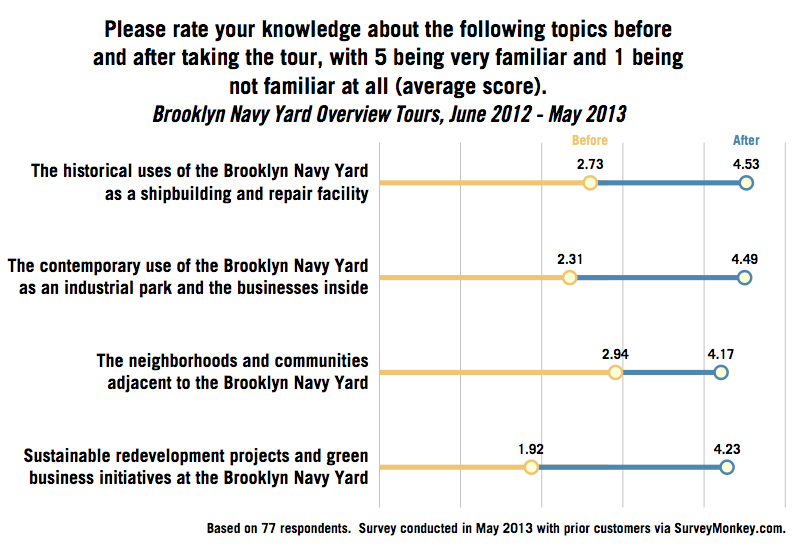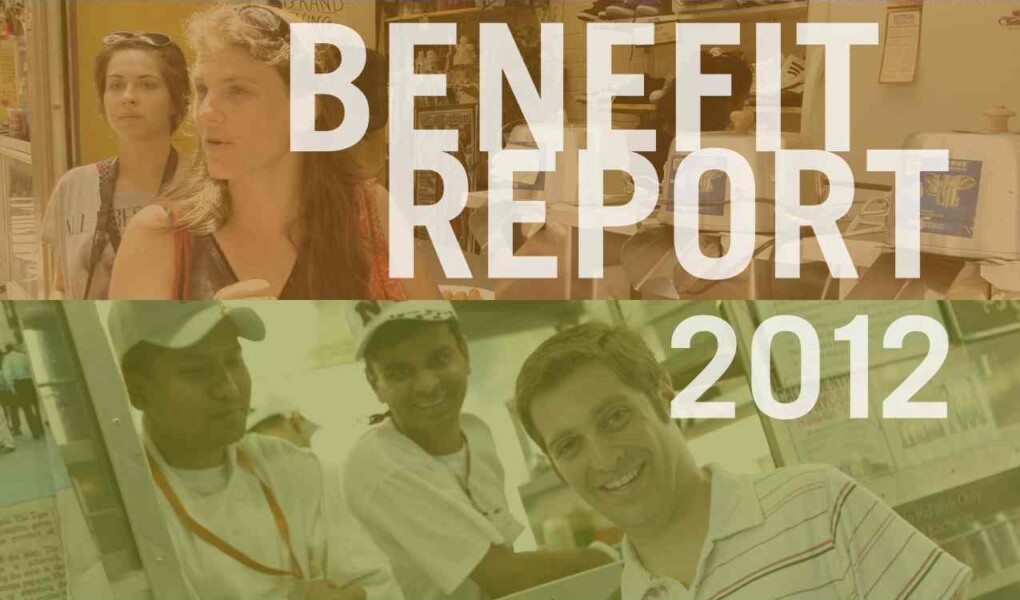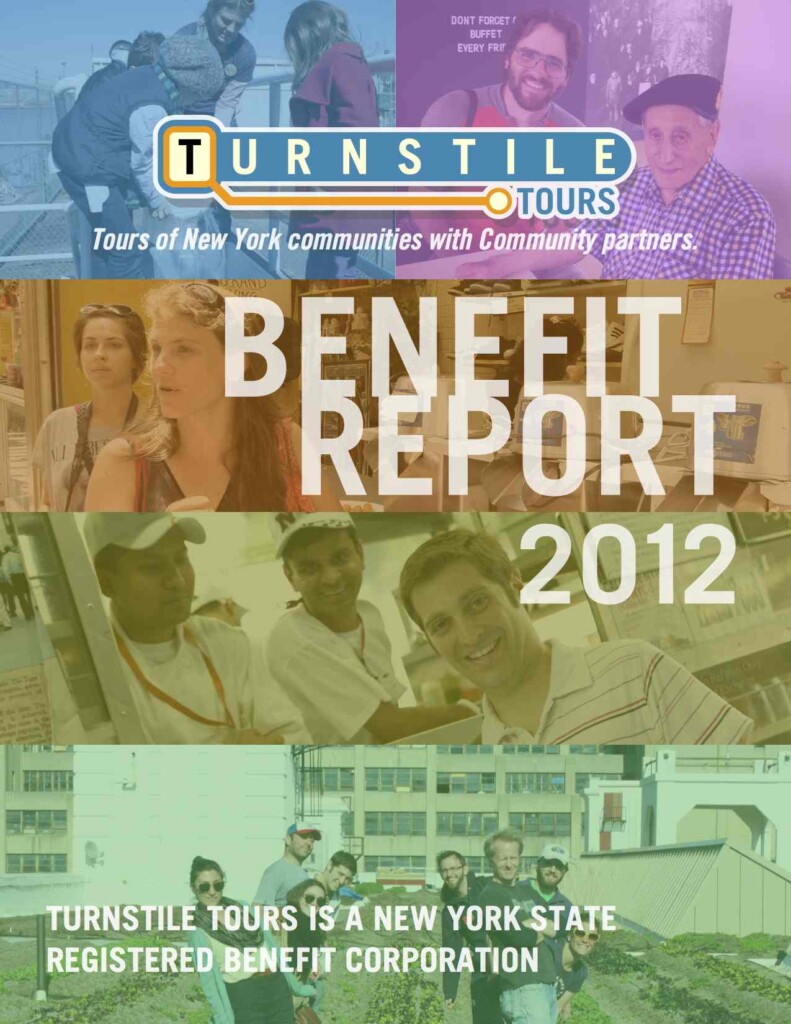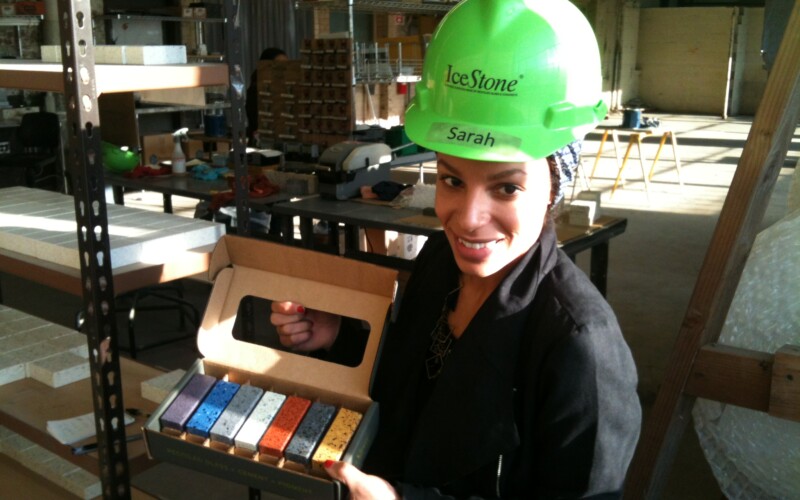You may have seen on our website or promotional materials that Turnstile Tours is a “New York State-registered Benefit Corporation” and wondered, what on earth does that mean? To answer that question, we have released our first annual Benefit Report, which we are excited to share with our partners, customers, stakeholders, and the general public.
So, what is a Benefit Corporation? Well, it’s a relatively new class of company in New York State – legislation creating them was enacted in December 2011, making New York the seventh state in the union to pass such a law. When Turnstile Tours was incorporated in May 2012, we became one of the first companies in the state to be organized under this new statute. Under the law, we must show our company provides a “positive material impact on society and the environment.” Of course, you don’t have to take our word for it – we are required to base our evaluation on a recognized third-party standard and publish the results in an annual report, which you can now read here.
We put this report together for a couple of reasons. As a company, our mission is to:
“… advance public knowledge about the meaning of place, foster connections and understanding between people of diverse backgrounds, and inspire and reflect a culture of community participation through providing welcoming, well-researched, inclusive, and engaging educational experiences and resources to people of all ages and abilities.”
That’s one packed sentence making some serious claims about our impact as a company. We take this responsibility very seriously, and we wanted to be able to evaluate progress on the claims we make in our mission statement.
As a company that is service- and education-driven, how were we going to measure our “positive material impact”? How could we prove that our tours aren’t just fun and informative, but actually have a measurable impact on society and the environment in the communities in which we work? To do this, we used two evaluation methods. First, we conducted a survey with customers who came on a Turnstile tour between June and December 2012 and asked them questions about their knowledge of certain topics and themes pre- and post-visit, and about concrete actions they took as a result of their tour, such as discussing the experience with peers, donating money to partner organizations, or returning to local businesses visited on the tour.

Second, we underwent a rigorous self-assessment using a third-party evaluation metric. We used the B-Lab B Impact Assessment, which evaluates our governance structure, business model, and community and environmental impacts. This tool helped us to investigate and measure how our business practices were sustainable (for example, by using local suppliers and recyclable supplies) and community-based (by driving capital to non-profits we partner with by donating a share of our revenue). The B Impact Assessment is used by hundreds of corporations large and small in order to become Certified B Corporations (a process we will be exploring in a blog post later this week). While we completed a self-assessment with the aid and guidance of the B-Lab team, and we did pass the evaluation handily (scoring 131.8 out of 200 possible points – a score of 80 is required to pass), Turnstile is hoping to become a Certified B Corporation following our first full, 12-month fiscal year in early 2014 (just to clarify, not all Certified B Corporations are registered Benefit Corporations, as this legal status does not exist in every jurisdiction, nor is it applicable to every type of company structure; conversely, not all Benefit Corporations are Certified B Corporations, as this is just one of many voluntary third-party evaluation standards).
Turning to our survey, we decided the best way to find out if we were achieving our mission was to ask our stakeholders and customers directly. Are our tours actually increasing public knowledge? Are they accessible to everyone? We crafted relative measures for the survey in which we asked tour participants to self-rate their knowledge and familiarity with sites, topics, and themes before and after the tour. If you already knew a lot about the Brooklyn Navy Yard’s history, did you leave our tour knowing even more? And how about your knowledge of its contemporary use? We were pleasantly surprised by the amount of movement we saw across a variety of categories. We were especially pleased with the awareness we were able to spread about the sustainable redevelopment projects and green business initiatives at the Brooklyn Navy Yard, as shown in the chart above.
We were equally excited about the results from our polling of attitudes before and after experiencing our Food Cart Tours. Food cart tour attendees said they were four times more likely to eat from a street vendor than they were before the tour – jumping to 73% from 18% – good news for our partners in the mobile food industry. That impact was magnified by the fact that 75% of our customers in 2012 came from the New York tri-state area, and more than 50% from the five boroughs of New York City, meaning that our vendors are likely to see our tour participants again in a line by their cart. The vendors will probably also see their friends, too, we imagine; what New Yorker doesn’t bring their friends to amazing places they found to eat? Sixty-four percent of respondents recommended a cart they ate at on the tour to a friend! But of all that we learned through our customer survey, nothing was quite as humbling as finding out that 90% of our tour attendees recommended the tour to someone else. What an honor!
The core of our self-evaluation and this report is the work we did with the B Impact Assessment. In the report, you can see for each area of evaluation – Governance, Community, Environment, and Impact Business Models – where we scored well on the metric, and where we plan to make improvements. Some of our major accomplishments included:
- 83% of all of our non-labor expenses were spent with independent companies located within 200 miles of our office
- 12% of Turnstile’s total revenue went to our non-profit partners, exceeding our stated goal of 5%
- We used almost exclusively post-consumer and/or compostable paper products for our food tours, and all of our printed materials were made by local companies that use only vegetable-based dyes
- We were able to demonstrate ways in which we followed not only our mission statement, but our four core commitments to conduct original research, contribute to public history, encourage cooperative learning and foster and atmosphere of mutual respect and inclusivity, and support our non-profit partners
Of course, there is always room for improvement, and our Benefit Report outlines specific areas where we can do better in every area of our business, from oversight to customer service to supply chains. We don’t view this report as a pat on the back, but as a guide for the future for how we can better fulfill our mission, better serve our customers, and be better stewards for the communities in which we work and the environment which we all share. Self-evaluation and improvement is not a once-a-year thing, but an ongoing process, and we rely greatly on the feedback we receive from the public to improve our experiences and better accommodate all of our visitors (please visit our contact page).
So, to all of our stakeholders, partners and customers who made the first year of Turnstile Tours successful: thank you! We hope that you will take the time to read at least some our 2012 Benefit Report, and that you will continue to attend and recommend our experiences, provide us with helpful feedback, and push us to be a better company.
You can read Turnstile Tours’ complete 2012 Benefit Report here. If you would like to experience one of our tours, we offer we wide variety of tours of the Brooklyn Navy Yard, including our new Urban Ecology Tour, Food Cart Tours of Manhattan’s Financial District and Midtown, our Immigrant Foodways market and neighborhood tour, and tours of the Brooklyn Army Terminal. Each of these tours is offered in partnership with a local non-profit organization. If you would like to book any of these tours as a private tour, please visit our Private Group Tours page.
This post was authored by Alex Tronolone and Andrew Gustafson.






